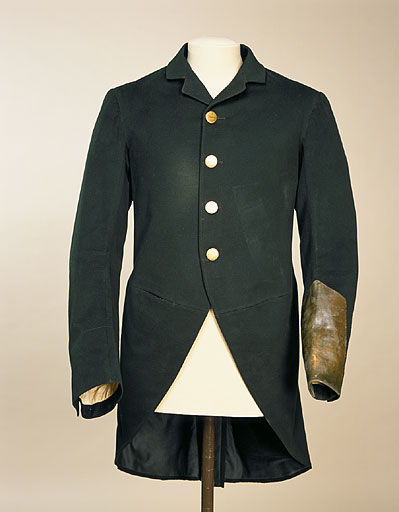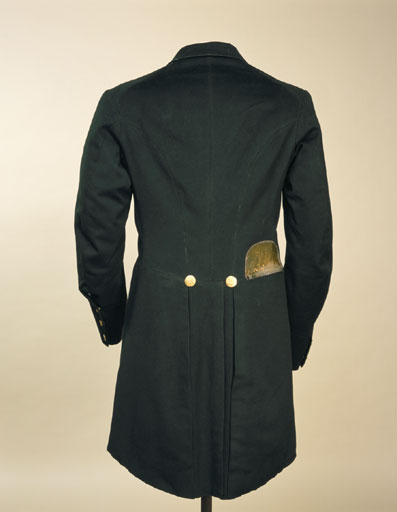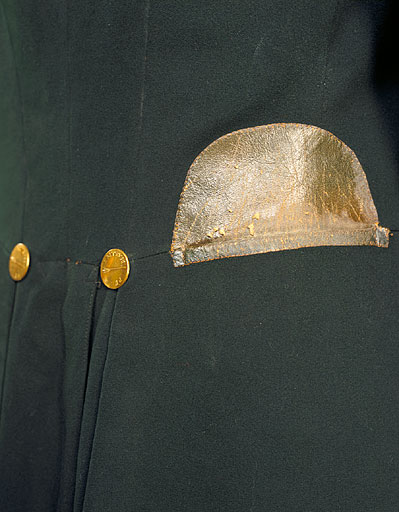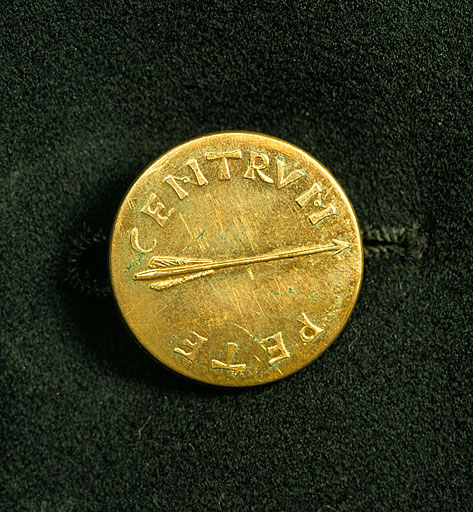archery coat
Summary
Green wool facecloth, lined with green cotton satin; fronts each in one section, faced with cloth; slit pocket of black twilled cotton, in facing of left front; fronts seamed at waist, fastening to four inches below round neck with turn-down collar and four brass buttons with raised design of arrow and "CENTRUM PETE" on each, and "Firmin & Sons / 153 / Strand, London" on reverse. Back in four shaped sections, seamed at waist except at centre back sections; skirt fronts curving to sides and extending to back open below waist with overlap; deep narrow pocket, white twilled cotton with leather-bound opening, in waist seam at right side; large pocket, black twilled cotton, in side-back skirt seams; long sleeves, lined white striped twilled cotton, in two sections, slightly gathered on shoulder; right sleeve with stitching imitating cuff and fastening at wrist with two smaller brass buttons; left sleeve, with leather patch over inner forearm and wrist, open at outside almost to elbow, fastening with four buttons, one missing, shoulders padded; lining padded above waist at each side. Cap: green cloth lined with fawn twilled silk and cotton round crown in eight triangular sections, meeting in centre under small cloth-covered button; stiffened crescent-shaped peak in front; press-fastener attaching centre front of crown, near edge, to centre of peak. Matching tie. Archery uniform for the Royal Toxopholite Society.
Display Label
The tradition of wearing Lincoln or "Sherwood Forest" green for archery dress, alluding to Robin Hood and his exploits, continued well into the nineteenth century (see man's jacket of about 1820 below), but darker greens and black were common by the 1880s. Male and female archery clothing in the nineteenth century generally followed the current fashionable silhouette, but included specific accessories such as a belt or sash to hold arrows and a shooting glove to protect the fingers. Archery was a sport of skill and precision suitable for both men and women, with participants aiming arrows at distant boards or "targets". As a pastime, it became extremely popular during the eighteenth century, with a renewed interest from the 1820s, especially for women players. Indeed, archery was considered to be one of the few suitable sporting amusements for women from the early nineteenth century until the 1880s. Women were encouraged to concentrate on their poise as much as for their talent, and a fine figure could cause much admiration, wearing an alluring outfit whilst holding a bow and aiming the arrow. (see below for the Punch cartoon "The Fair Toxophilites" from the middle 1860s)George Eliot commented in 1876 in her novel Daniel Deronda "who can deny that bows and arrows are among the prettiest weapons in the world for feminine forms to play with?"
Object Name
archery coat
Creators Name
Date Created
1880-1900
Dimensions
Length (coat): 94cm
Cap:
accession number
1954.996/2
Place of creation
England
Medium
Legal
© Manchester Art Gallery




